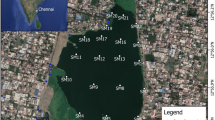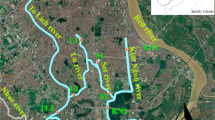Abstract
A suite of heavy metals was monitored at sediments and overlying water in three urban lakes located in Seoul, Korea during spring season 2006. Metals measured were zinc, arsenic, chromium, copper, nickel, and cadmium. All metal concentrations in urban lake sediments were much higher than those in natural lake sediments. Elevated metal levels in urban lake sediments are associated with urban runoff, including street dust polluted by heavy metals. Metals in sediments from urban lakes were extracted with a weak electrolyte solution (0.1 M Ca(NO3)2) to predict the toxicity of metals. Among the six heavy metals studied, Cu was the most extractable, followed by Ni and Zn. Ca(NO3)2-extractable metal recoveries has a good relationship with metal toxicity based on Chironomus riparius bioassay. This study showed that urban stressors such as vehicle emissions could increase the concentration of heavy metals in urban lake sediments. In addition, there is a positive relationship between sediment toxicity by using C. riparius bioassay and Ca(NO3)2-extractability of heavy metals from sediments.
Similar content being viewed by others

References
An, Y.-J., & Kampbell, D. H. (2003). Total, dissolved, and bioavailable metals at Lake Texoma marinas. Environmental Pollution, 122, 253–259.
Arjonilla, M., Gomez-Parra, A., & Forja, J. M. (1994). Sediment analysis does not provide a good measure of heavy metal bioavailability to Cerastoderma glaucum (Mollusca:Bivalvia) in confined coastal ecosystems. Bulletin of Environmental Contamination and Toxicology, 52, 810–817.
Basta, N., & Gradwohl, R. (2000). Estimation of Cd, Pb, and Zn Bioavailability in smelter-contaminated soils by a sequential extraction procedure. Journal of Soil Contamination, 9, 149–164.
Conder, J. M., & Lanno, R. P. (2000). Evaluation of surrogate measures of cadmium, lead, and zinc bioavailability to Eisenia fetida. Chemosphere, 41, 1659–1668.
Conder, J. M., Lanno, R. P., & Basta, N. T. (2001). Assessment of metal availability in smelter soil using earthworms and chemical extractions. Journal of Environmental Quality, 30, 1231–1237.
Fargašová, A. (2001). Winter third- to fourth-instar larvae of Chironomus plumosus as bioassay tools for assessment of acute toxicity of metals and their binary combinations. Ecotoxicology and Environmental Safety, 48, 1–5.
Forstner, U., & Wittmann, G. T. W. (1979). Metal pollution in the aquatic environment. Berlin: Springer.
Hamilton, M. A., Russo, R. C., & Thurston, R. V. (1977). Trimmed Spearman–Karber method for estimation median lethal concentrations in toxicity bioassays. Environmental Science & Technology, 11, 714–719.
Khangarot, B. S., & Ray, P. K. (1989). Sensitivity of midge larvae Chironomus tentans fabricus (Diptera Chrionomidae) to heavy metals. Bulletin of Environmental Contamination and Toxicology, 42, 325–330.
Korean Ministry of Environment (2006). Development of integrated methodology for evaluation of water environment.
Louma, S. N. (1989). Can we determine the biological availability of sediment-bound trace elements? Hydrobiologia, 176/177, 379–396.
Milani, D., Reynoldson, T. B., Borgmann, U., & Kolasa, J. (2003). The relative sensitivity of four benthic invertebrates to metals in spiked-sediment exposures and application to contaminated field sediment. Environmental Toxicology and Chemistry, 22, 845–854.
Nebeker, A. V., Cairns, M. A., & Wise, C. M. (1984). Relative sensitivity of Chironomus tentans life stages to copper. Environmental Toxicology and Chemistry, 3, 151–158.
OECD (2004). Sediment–water chironomid toxicity using spiked sediment. OECD Guidelines for Testing of Chemicals, No. 218. Paris.
Rierzynski, G. M., & Schwab, A. P. (1993). Bioavailability of zinc, cadmium, and lead in a metal-contaminated alluvial soil. Journal of Environmental Quality, 22, 247–254.
Sansalone, J. J., Buchberger, S. G., & Al-Abed, S. R. (1996). Fractionation of heavy metals in pavement runoff. Science of the Total Environment, 189/190, 371–378.
Sezgin, N., Ozcan, H. K., Demir, G., Nemlioglu, S., & Bayat, C. (2003). Determination of heavy metal concentrations in street dust in Istanbul E-5 highway. Environment International, 29, 979–985.
US EPA (1999). Trimmed Spearman–Karber. Office of Research and Development National Exposure Research Laboratory-Ecosystems Research Division, Center for Exposure Assessment Modeling. Cincinnati, OH.
Weimin, Y., Batley, G. E., & Ahsanullah, M. (1994). Metal bioavailability to the soldier crab Mictyris longicarpus. Science of the Total Environment, 141, 27–44.
Author information
Authors and Affiliations
Corresponding author
Rights and permissions
About this article
Cite this article
Baek, YW., An, YJ. Assessment of toxic heavy metals in urban lake sediments as related to urban stressor and bioavailability. Environ Monit Assess 171, 529–537 (2010). https://doi.org/10.1007/s10661-009-1297-7
Received:
Accepted:
Published:
Issue Date:
DOI: https://doi.org/10.1007/s10661-009-1297-7



